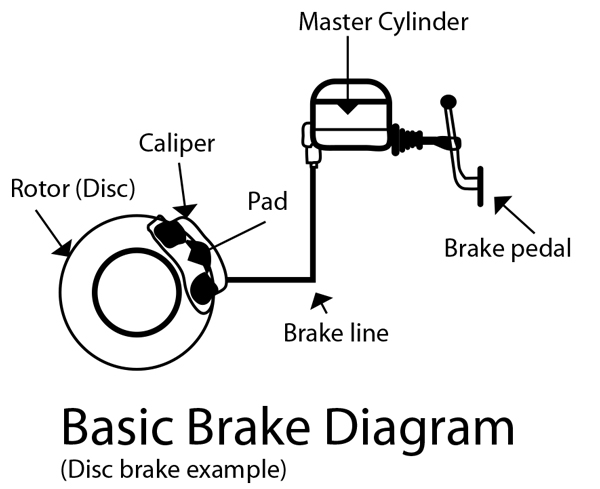Basic operation of your braking system

Your car's braking system is vital to your family's safety. Most vehicles weight anywhere from one to two tons, some even more - once that tonnage is moving forward, it will take an equal amount of energy to stop it. Sticking your foot out like Fred Flintstone just won't get it done.
The brake system delivers to the brake pads (either drum or disk) a measured amount of hydraulic force as to apply pressure to the brakes drum or rotor to slow the rotation of the tires; the more pressure applied, the more force that will be applied which will absorb the energy of the rotating tires. The energy. The energy is displaced as heat which is why it is important to ensure your brakes are well ventilated. As your brakes become worn, stopping distances only get further.
Your vehicle's braking system is made up of various parts such as the master cylinder, brake lines and hoses, brake pads, rotors, brake pedal, automatic hydraulic control system (if your car is equipped with anti-lock brakes (ABS)), and brake fluid.
The Master Cylinder
The brake system's master cylinder is usually found on the engine compartment's fire wall on the driver's side of the vehicle (U.S. style vehicles). It is made up of three main components; a double cylinder, piston assembly, and a fluid reservoir. When the brake petal is engaged, the master cylinder is the vehicle's device that will increase the pressure to the hydraulic fluid in the brake lines that forces the wheel cylinders (for drum brakes) or the wheel's calipers (for disc brakes) to apply pressure to the brake pads to the brake drum (for drum brakes) or the disc (for disc brakes). This action, depending on the force applied, will slow or stop completely the rotation of the tire(s).
The Caliper
The brake caliper houses two brake pads and a piston that translates the hydraulic pressure delivered by the brake hose via the brake line into a pinching action on the two brake pads. The pinching action brings the two pads that are on either side of the rotor (disc) in contact with the milled section. The resulting friction is what slows or stops the tire's rotation.
During drum brake operation, the movement of the pads is outward toward the inside milled portion of the outer wall of the drum to create the friction required to slow or stop the vehicle.
The Rotor and Drum
The rotor (disc) is commonly made of cast iron and milled smooth on both sides to a specific width. This milled area is where the brake pads that are set into the caliper will make connection during the time the break pedal is depressed. The friction between the disc and the pad is what slows or stops the rotation of the tire.
The brake drum is a housing that is also commonly made from cast iron, usually found on the rear wheels when the vehicles system is not the preferred four wheel disc brake set-up, that is milled smooth on the inside outer wall in order to efficiently accept the brake shoes (pads). The drum brake, like the disc brake, uses the friction created by the pressure between the drum and the pads to slow or stop the tires rotation.
Brake Lines and Hoses
As you may imagine, the brake fluid's pressure that is delivered to ultimately move the brake pads can be high. The lines and hoses used to transmit that pressure need to be up to the task.
The brake line is a system of rigid steel tubing that runs from the master cylinder and along the vehicle's chassis to each of the four wheel's brake assemblies. The tubing must be flared at each end to ensure a proper fitting -- for reasons that should be obvious, you do not want a weak connection any where in your brake system, and flared connections help ensure the connection is strong.
The brake hose is a flexible hose covered with rubber. This hose will complete the fluid's journey to the wheel's brake assembly. Only about six to eight inches in length (lengths do vary depending on make and model), the hose allows for the tire's movement in relation to the fixed position of the vehicle's frame.
Brake Pads
Brake pads come in a multitude of types. The type you would use should be based on the vehicle's manufacturer's recommendation and for the intended general use of the vehicle. The materials used to make the pad vary widely from asbestos, ceramic, steel and even certain types of plastic.
The ABS System
The ABS system (if installed) in the right conditions will pulse the brake fluid providing a safe moderated flow helping to ensure the brakes will not lock up which could cause an uncontrolled skid, and/or potentially hazardous slide.
